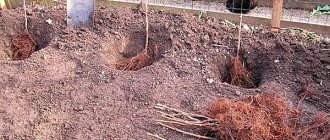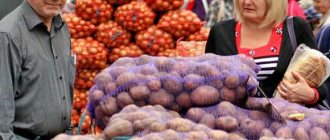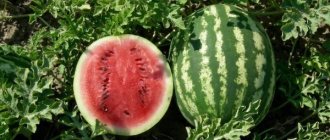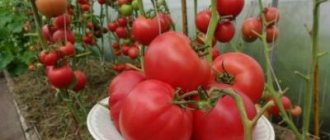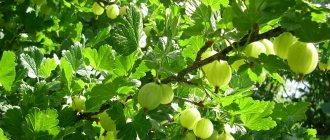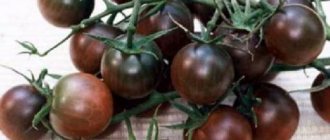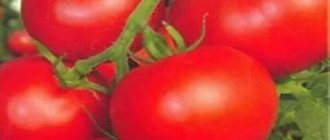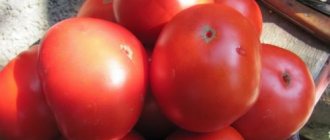Types of watermelons
Watermelon (Citrullus) is one of the genus of the pumpkin family. In the wild, its representatives are found in Africa, as well as Central and South Asia. According to various sources, this includes from 5 to 7 species, but only 2 of them are used by humans:
- colocynth (Citrullus colocynthis);
- common watermelon (Citrullus lanatus).
Colocynth is a perennial plant with a creeping stem and small fruits that acquire a light yellow color after ripening. It is widely distributed in North Africa, the Mediterranean region, the Arabian Peninsula and parts of Pakistan and India. Local residents use the dried fruits of colocynth, which have a bitter taste, as a medicine. In addition, oil is often produced from its seeds.
Residents of North Africa and the Arabian Peninsula use the dried fruits of watermelon colocynth to treat constipation and liver diseases.
The common watermelon is an annual herbaceous plant with a spherical or oval edible pumpkin fruit. Its homeland is South Africa. Scientists distinguish two varieties of this plant:
- Tsamma melon (Citrullus lanatus var. citroides) is a wild plant widely distributed in South Africa;
- Cultivated watermelon (Citrullus lanatus var. lanatus) is a melon crop valued for its sweet, large fruits and grown in many countries around the world.
We love watermelons for their juicy, sugary pulp and large size - the most convenient berry!
What does yellow watermelon taste like?
Watermelons with yellow flesh are now offered to customers under the name pineapple, although the similarity of these fruits is limited only by the beautiful shade of the slices, and the color change does not affect the taste of yellow watermelon.
Russian breeders offer summer residents to try pineapple watermelons collected from their own beds. Watermelons of the Lunny variety are ready for harvesting 70–75 days from the moment the seedlings peck. The fruits with attractive striped skin grow up to 3.5–4 kg and have excellent taste characteristics.
The hybrid of domestic selection Prince Hamlet F1 is distinguished not only by its early maturity. Its main “zest” is hidden under a dense thin bark. The flesh of this pineapple watermelon, weighing up to 2 kg, is lemon-yellow and sweet.
But the watermelon variety in the photo, Gift of the Sun, can easily be confused not with a pineapple, but with a melon, since the fruits of this plant have a surprisingly yellow, smooth bark, very reminiscent of the peel of another popular melon crop. This yellow watermelon, thanks to the accumulation of up to 12% sugar, has an excellent taste, juicy pulp consistency and early ripening.
Today, breeding companies in Holland, the USA and Japan are actively working in the field of obtaining diploid hybrids that produce seedless watermelons. For several years now, such fruits, completely devoid of seeds or having only their rudiments, have been grown in our country.
An example of this is the hybrid yellow watermelon Prince Hamlet and the oblong watermelon of the American selection Stabolite F1.
The best varieties and hybrids
Nowadays, there are many varieties and hybrids of watermelons. They differ from each other in the size of the fruit, the color of the bark and pulp, as well as taste. But when choosing a variety, special attention should be paid to its adaptability to the natural conditions of a particular region, as well as to the timing of fruit ripening.
The variety of modern varieties of watermelons is amazing: red, yellow and even snow-white
For the Leningrad region and the North-Western region
The climate of the Northwestern region is not suitable for growing watermelons. The average daily temperature of the hottest month in the Leningrad region is only 18.8 °C, which is clearly low for this heat-loving crop. In addition, it suffers from lack of sun and excess humidity. Early watermelons with small fruit size have the greatest chance of ripening in the North-West region. These varieties include:
- Sugar Baby (Sugar Baby);
- Sugar Delicata;
- Ultra early;
- Prince of Denmark;
- Juicy slice;
- Ultra-early Dutin (SRD 2).
Sugar Baby (Sugar Baby)
Sugar baby is an early-ripening, unpretentious variety that can withstand low spring temperatures. Despite the fact that the Russian Federation State Commission for Testing and Protection of Breeding Achievements recommends this variety only for the Central Black Earth Region, it is successfully grown by gardeners in many regions, including the North-West.
Sugar Baby fruits are small in size with a dark green thin rind and bright red flesh. Depending on the conditions, their weight ranges from 1 to 5 kg. The taste of the fruit is very sweet, the pulp has a delicate aroma.
The fruits of the Sugar Baby watermelon are small, but very tasty, ripen quickly, and are unpretentious.
Sugar Baby!
It will always grow, the fruits are small. Apelsinos
https://www.forumhouse.ru/threads/173077/page-36
Prince of Denmark
Prince of Denmark is a modern hybrid of watermelons, included in the State Assortment Register in 2013 as a crop recommended for cultivation in all regions of our country. He feels great in the North-West.
Hybrids are plants obtained by crossing two or more varieties to improve certain qualities. Their offspring do not retain their parental characteristics, so the seeds of hybrids cannot be used for replanting.
The Prince of Denmark watermelon is a climbing plant with spherical fruits, the average weight of which is 1.8–2 kg. Under particularly favorable conditions, it can increase to 4–6 kg. The bark of the fruit is dark green with barely visible stripes. The dark red, dense pulp has an excellent dessert taste and contains a large amount of sugars (about 8%).
The watermelon hybrid Prince of Denmark has been grown in Russia relatively recently, but has already gained well-deserved popularity among gardeners in our country
Prince of Denmark ripens within 75–80 days after germination. From one square meter of plantings you can collect 2.8 kg of fruit.
Ultra-early Dyutina (SRD 2)
Super early Dyutina is one of the fastest ripening varieties of watermelon. Its fruits ripen within 55–60 days after germination. A distinctive feature of SRD 2 is the growth of a single stem without the formation of lateral shoots. The length of the main lash is 1.5–2 meters. Due to the lack of tendrils, the lashes require manual laying and powdering.
When growing watermelons of the SRD 2 variety, there is no need to trim the side shoots, which makes caring for the plant much easier
SRD 2 fruits are characterized by a light green rind with dark stripes and red granular flesh with a sweet taste and delicate aroma. Their weight reaches 2–3 kg. Thanks to the rather thick rind, watermelons of this variety tolerate transportation well and retain their taste for a month after harvesting. In addition, they are highly resistant to anthracnose.
For the Central region and Moscow region
The Central region is characterized by a greater number of sunny days and less precipitation than in the North-West. Thanks to this, watermelons feel much more comfortable here. Gardeners in the Center of Russia successfully grow many early and mid-early varieties and hybrids of watermelons on their plots, including:
- Charleston near Moscow;
- A gift to the north;
- Beijing Joy;
- Basketball;
- Dolby;
- Gift of the sun, etc.
Video: review of successful and unsuccessful varieties for the Moscow region
Charleston near Moscow
The Moscow Region Charleston hybrid has proven itself well in the Central region of our country. It takes 80 days for its tasty and fairly large fruits to ripen.
Charleston watermelons near Moscow have an elongated shape. The color of the bark is dark green. The pulp is red, dense, granular with a pleasant sweet taste. The weight of the fruit often reaches 5–8 kg.
Watermelons of the Moscow Charleston variety are similar in shape to a melon: oblong, large, thin rind, incredibly sweet flesh
Charleston, located near Moscow, captivated us with its problem-free nature; it is always the first to set fruit, even in not very good weather, when some varieties do not want to set.
For these reasons, I can’t give it up; the second year has paid off. Well, quite tasty. Lena13
https://www.forumhouse.ru/threads/173077/page-54
Beijing joy
Beijing Joy is a variety series that includes several watermelon hybrids:
- Beijing joy is a delicacy;
- Beijing Farmer's Joy;
- Beijing peasant joy;
- Beijing joy is light;
- Beijing joy is great.
All these hybrids were born in China, the recognized leader among the countries in the world in the production of watermelons. Their advantages include:
- early ripening (75–90 days from germination);
- beautiful appearance of the fruit with a green striped rind and bright red flesh;
- excellent sweet taste;
- quite large fruit size (from 4 to 8 kg).
The Beijing Joy variety series is very popular among gardeners in the Central region: the watermelons are tasty, sweet, and grow well
100% I think the variety for all beginners is Beijing great joy.
It grows very well, sets, ripens and is a good size. 7 kg. but if further south there will be more. The second among Beijing is Beijing Farmer's Joy. Very tasty, sweet, but the damn thing is so climbing! coconut76
https://www.forumhouse.ru/threads/173077/page-36
Gift of the sun
Gift of the Sun is a Dutch hybrid with an original appearance. Its thin and fragile crust is golden-yellow in color with dark stripes. At the same time, the fruit pulp retained the classic red color of watermelons and a delicate sweet taste.
Watermelons of the hybrid Gift of the Sun have not only an unusual appearance, but also an excellent taste; bright pink flesh is hidden under the yellow rind
Gift of the Sun is one of the early ripening hybrids. Its fruits reach full maturity 65–75 days after emergence. The weight of watermelons varies from 1.5 to 3.5 kg. The average yield of one square meter of plantings is about 3–3.5 kg.
The fruits of the Gift of the Sun do not tolerate transportation well. Their shelf life is also short, usually it does not exceed 15–20 days from the moment of collection.
Early, juicy and sweet, thin skin.
The vine is not very long; they left one main one and formed one fruit on it. Grew up in a greenhouse. Sown on 24.04, sprouted on 01.05, ovary from 22.06 and 28.06. Removed 30.07–1kg300g and 06.08–1kg800g. They turned out not big, but tasty. During the tasting, a neighbor noticed that there were a lot of small seeds in the fruit, but Irina
https://www.tomat-pomidor.com/newforum/index.php/topic,9079.0.html
For the Altai Territory
Few people know that Altai is not inferior to the south of Russia in terms of the number of sunny days per year. Summer here is usually hot and dry, but quite short. This climate makes it possible to grow many varieties and hybrids of watermelons, including large-fruited ones. These include:
- Crimson Sweet;
- Early Kuban;
- Siberian;
- Top Gun;
- Charleston grey;
- Siberian lights.
Crimson Sweet
Crimson Sweet is a French hybrid of watermelons that has gained popularity in many countries around the world. Its characteristic feature is the large size of the fruits (up to 12 kg), which ripen in 75–80 days, even in the conditions of the Altai Territory.
Crimson Sweet watermelons grow and ripen well in the Altai region, they have a fairly thick rind, few seeds, and sweet, thick red flesh.
The color of the Crimson Sweet hybrid is dark green with light longitudinal stripes. The ripe pulp is dark red, with a wonderful sweet taste and delicate aroma. Watermelons of this hybrid are resistant to fusarium and anthracnose, and are also perfectly stored.
Crimson Sweet - tasty, grew shoots very powerfully, only managed to peel them off, resisted infection the longest, grew the largest fruit
Kransh
https://dacha.wcb.ru/index.php?showtopic=43777&st=1160
Siberian lights
A variety bred by employees of the West Siberian Vegetable Experimental Station VNIIO specifically for the cold regions of our country. It tolerates lack of sun and sudden temperature changes well. In the conditions of the Altai Territory, the fruits of the Sibirskie Ogni variety ripen 78–95 days after emergence.
Video: personal experience of growing the Siberian Lights variety in the Altai Territory
The fruits of Siberian Lights are dark green with barely noticeable almost black stripes. The pulp is bright red, with a pleasant sweet taste. The average weight of watermelons is 1.5–2 kg. In the Altai Territory, from 154 to 340 centners of fruits are harvested from one hectare of plantings of this variety.
For Primorye
Despite the rather harsh climate, watermelons were grown in the Primorsky Territory back in Soviet times. Today, our country’s Variety Register contains more than 30 varieties and hybrids approved for cultivation in this region. Among them:
- Light;
- Yarilo;
- Trophy;
- Skorik;
- Photon;
- VNIIOB 2.
Ogonyok
One of the oldest varieties of watermelons, included in the Variety Register back in 1960. Ogonyok is characterized by black-green fruits with orange-red sweet pulp, the weight of which does not exceed 2.5 kg. They usually ripen 70–85 days after emergence.
Watermelons of the Ogonyok variety ripen quickly, thrive in the coastal climate, and are resistant to major diseases
Among the disadvantages of the Ogonyok variety, gardeners note a thin and fragile crust, due to which its fruits cannot be transported or stored for long periods of time.
At first I also planted Ogonyok, but then I gave up... the fruits are small, but very good.
sweet .. and watermelons are prone to rotting .. you need to somehow grow it skillfully. Previously, in Soviet times, it was mainly the Koreans who sold them here, they were dark, dark green, almost black, very tasty. Sergey778
https://dacha.wcb.ru/index.php?showtopic=16656&st=677
Skorik
Skorik is an early ripening variety bred by the All-Russian Research Institute of Irrigated Vegetable and Melon Growing (Astrakhan). Its green fruits with dark stripes are highly valued by gardeners for their bright red, juicy, sweet pulp with a strong watermelon aroma.
Depending on weather conditions, the ripening period for watermelons of this variety ranges from 62 to 87 days from the moment of germination. The average fruit weight is 2–4 kg. They are stored quite well and transported without much loss. Skorik is weakly susceptible to anthracnose, bacterial spot and powdery mildew.
Watermelons of the Skorik variety feel good in the greenhouse and on the open ground, fully ripen in less than three months
For Ukraine and Southern Russia
The climate of most regions of Ukraine and southern Russia is ideal for growing watermelons. Hot and long summers allow even the largest-fruited varieties to ripen.
Today there are many varieties and hybrids suitable for growing in these regions. But the following are especially popular among melon growers:
- Bomb;
- Producer;
- Charleston Gray;
- Astrakhan;
- Bykovsky 22;
- Triumph;
- Chill, etc.
Bomb
Modern mid-season hybrid. From the moment of emergence of seedlings until the fruits reach technical ripeness, 83–86 days pass. The weight of watermelons of this hybrid is 4–8 kg. The yield reaches 425 centners per hectare.
Light green with dark stripes, Bomba fruits have a broadly elliptical shape. The pulp is red, dense, with an excellent sweet taste. Watermelons of this variety can easily withstand transportation and retain their characteristics when stored for 37–40 days.
Video: tasting the fruits of the Bomba hybrid
Astrakhan
The time-tested variety of watermelons is still popular today. Residents of Ukraine and the southern regions of Russia have been cultivating it for more than 40 years. Its main advantages are:
- excellent sweet taste;
- high yield (up to 48 tons per hectare);
- mid-early ripening period (70–80 days from the moment of emergence);
- unpretentiousness to adverse conditions;
- resistance to anthracnose and fusarium wilt;
- good keeping quality and transportability of fruits.
Astrakhan is one of the most popular varieties of watermelons in Ukraine and southern Russia, sweet, productive, resistant to diseases and pests
Among the disadvantages of this variety, melon growers note the likelihood of voids appearing in the pulp during a prolonged drought. But they have virtually no effect on the taste of the fruit or its keeping quality.
Chill
Kholodok is a mid-late variety of watermelons, bred at the Bykovskaya melon breeding experimental station (Volgograd region). It is a very powerful plant with a large number of lashes. Its green fruits with almost black stripes have an elongated spherical shape. Their average weight is about 4.5 kg. The ripe pulp is pinkish-red, granular, with a sweet taste and delicate aroma. From one hectare of melons, 14–28 tons of watermelons are collected, which are well stored for 3 months.
Video: collecting watermelons of the Kholodok variety
How to choose a variety or hybrid based on ripening time
The choice of crop for cultivation in a particular region depends on the period of fruit ripening . All varieties are suitable for southern territories. In the northern parts, the harvest comes exclusively early.
Description and characteristics
In irrigated areas, the average yield of watermelons is 400-500 c/ha, in non-irrigated areas - 200-250 c/ha. Under favorable growing conditions, some fruits reach a weight of 26 kg or more.
Amateur melon growers grow on average 6-8 kg per square meter. m . Some manage to achieve a yield of up to 20 kg per square meter. m.
- Most modern watermelons ripen in 60-80 days. Early ripening fruits are unpretentious in care and tolerate heat and cold well. In the southern regions they can reach a weight of up to 15 kg. The most popular of the early ripening ones: Sandai Special, Sugar Baby, Eureka, Lady F1, Lunar, Regus F1, Ogonyok, Zenit and others.
- Mid-season species ripen in southern soil and northern greenhouses. Such varieties gain the required mass in the open air of the North Caucasus and in the lower reaches of the Volga. In the northern areas, these fruits can only ripen in greenhouses and greenhouses. This requires proper care and high-quality agricultural technology. The most popular mid-season varieties and hybrids: Delicatessen F1, Volzhanin (pictured), Crimlong F1, Florida F1, Crimson Sweet, Black Prince, etc.
- Late-ripening varieties and hybrids ripen slowly. They are cultivated in regions with warm climates and long summers. They need to be cut in September or November, depending on the weather. For planting, it is better to choose varieties: Kholodok, Chervonny Korol, Icarus, Lyubimets of Pyatigorsk, etc. Their disadvantage is that it is often difficult to determine ripeness. A seemingly large and ripe fruit may turn out to be unripe.
Features of planting watermelons
The first steps towards planting watermelons are:
- Choosing a location.
- Soil preparation.
Preference should be given to sunny, wind-protected areas of the garden. The best predecessors of watermelons are cabbage, onions, legumes or cereals. Experts categorically do not recommend planting them in beds where pumpkin or nightshade crops grew last season.
Watermelons prefer light soil; they grow especially well on virgin sandy loam chernozem. If the soil is dense and clayey, then it needs to be loosened. This can be achieved by adding humus along with straw and sand. It is better to carry out the procedure in the fall, or, as a last resort, in early spring, immediately after the snow melts.
Proper seed preparation is also very important. Before planting, they are soaked in warm water for 24 hours. This procedure will allow you to get faster and friendlier logins. Some gardeners additionally slightly cut the spouts of watermelon seeds.
Sowing seeds in open ground
Watermelon seeds are sown in open ground only in warm regions . Usually sowing is done in the second half of April - early May. The main condition for successful seed germination is warming the soil to 12–14 °C. Otherwise, they may die or be significantly delayed in development.
In pre-watered holes (6–8 cm deep), placed at a distance of at least 1 meter from each other, place 2–3 seeds and cover them with fertile soil. The first shoots usually appear after 5–7 days. If several plants have sprouted in one hole, then choose one, the strongest, and remove the rest.
Watermelon seedlings are thinned out at the stage of 3–4 true leaves to get a large harvest
We grow seedlings
In most regions of Russia, the seedling method is preferred. With its help, you can speed up the ripening of fruits by 20–30 days. Seeds are sown a month before warm weather sets in. This period usually occurs at the end of April.
To obtain seedlings, each seed is placed in a separate container with a mixture of peat, turf soil and sand with a volume of at least 300 ml, watered and covered with a transparent lid to create a greenhouse effect. The air temperature when germinating watermelons should not be below 25 °C. At night, it is permissible to reduce it to 18 °C.
Shoots appear in a few days. Further care for them consists of timely watering and loosening the soil, creating favorable conditions. Watermelon seedlings develop well at a temperature of 16–18 °C and a twelve-hour daylight hours, the latter can be provided with additional lighting. If these rules are not followed, there is a high probability of seedlings being pulled out and a general weakening of the plants.
Video: secrets of high-quality watermelon seedlings
Before planting in open ground, seedlings must be hardened off. To do this, they are taken outside for a short time, gradually increasing the time spent in the fresh air. Young plants are planted in the garden bed after the appearance of the fourth true leaf. This must be done very carefully, without damaging the earthen coma.
Varieties of watermelons for the Krasnodar region. 5 productive varieties of watermelons
Every gardener dreams of having high-quality varieties of fruits, vegetables, and berries on their plot with high yields. Today I will tell you about several of the most productive varieties of watermelons.
"Sugar Baby"
This variety has a fairly high yield: about 100 tons ripen per 1 hectare of land. The weight of one berry varies from 3 to 5 kg. The peel is green, with dark thin stripes. Watermelon has juicy red flesh. The variety is resistant to powdery mildew.
"Charleston Gray"
Ripens in volumes of up to 100 tons per hectare. There are no stripes on the peel, the color of the peel is light green. The pulp is sweet, bright pink. The fruit is oval and elongated. One berry reaches a mass of 14 kg.
"Crimson Sweet"
The yield is slightly less than the first 2 varieties - about 65 tons. The stripes on the peel are light, while the peel itself has a dark green tint. The flesh is red, with a juicy crunch. The fruit is very sweet. The weight of the fruit varies in the range of 8 – 10 kg. The variety is resistant not only to drought, but also to frost.
The fruit has a black-green peel and red, very juicy pulp. The berry is not very large: on average it weighs about 2.5 kg. “Ogonyok” is highly resistant to diseases such as anthracnose, fusarium, and also tolerates frost well. About 35 tons of watermelons ripen on 1 hectare.
"Chill"
This variety survives transportation and storage well. Once harvested, it can be stored for up to 5 months. The peel is dark, green in color and has light spots on the surface. The inside of the watermelon is bright red. Very sweet. The weight of the fetus is 5-7 kg. Resistant to diseases such as fusarium.
Growing watermelons
Watermelons can be grown both in greenhouses and in open ground. Each of these methods has its own characteristics and important nuances.
In the open ground
Watermelons are planted in open ground in regions with long and hot summers. In central Russia and other regions with insufficiently warm climates, only early varieties of watermelons are grown in this way. In order to reduce the negative effects of weather conditions, plantings are often covered with film or non-woven material.
The film protects the root system of watermelons from hypothermia and helps retain moisture in the soil
When grown in open ground, watermelon bushes need shaping. It is carried out immediately after the appearance of the ovaries.
Formation step by step:
- The main stem is cut at the level of 4 leaves after the fruit.
- Several side shoots are pinched, leaving no more than two ovaries on them, and the excess lashes are completely removed.
Large-fruited varieties of watermelons are grown in one vine. With this method of formation, all side shoots are cut off and only the main stem is left, which is pinched after the fruit has formed.
Video: how to shape watermelons
In the greenhouse
In the northern regions, watermelons are often grown in greenhouses. For rapid plant development and fruit formation, a temperature of 25–30°C is required. In addition, the greenhouse must be periodically ventilated to combat excess humidity and condensation.
In areas with cold climates, when growing watermelons in a greenhouse, a warm bed is often used. To set it up you need:
- Dig a trench at least 30 cm deep.
- Fill it with a mixture of humus, straw, sawdust and other organic matter.
- It is good to pour hot water over the trench.
- Cover the resulting pillow with previously removed soil.
5–7 days after arranging the bed, watermelon seedlings are planted on it. The distance between plants should not be less than 70 cm.
Indoors, watermelons are most often grown in one vine, which is tied to a vertical trellis. The set fruits, after they reach a weight of 200–300 grams, are placed in well-secured nets. This helps to avoid the fetus being torn away from the lash under the influence of gravity.
In closed ground, watermelons ripen well even in the northern regions - most often a vertical trellis is used for them
Gardeners who grow watermelons indoors often experience difficulties with their natural pollination and carry out the procedure manually. To do this, you need to take a brush and use it to transfer pollen from male flowers to female flowers. If pollination is successful, the ovary begins to quickly increase in size. Otherwise, the female flower dries up and falls off, in which case pollination is repeated with a new flower.
The optimal time for pollination is early morning, when the air temperature in the greenhouse has not risen above 20 °C.
Unusual types of pumpkin culture
Thanks to their efforts and ingenuity, some farmers turn everyone’s favorite berry into a curiosity. For example, a farmer from Arizona managed to grow a real giant watermelon. The huge berry, which was named Carolina Cross, reached a weight of 122 kg.
There are large varieties of watermelons in our country. These include the following types of culture: Palladin F1 (20 kg), Crimson glory F1 (up to 16 kg), Astrakhan (10 kg), Charleston gray (up to 12 kg) and Russian size (over 60 kg).
Farmers from Japan found it necessary to diversify the shape of the fruit for successful transportation. Regardless of the type of watermelon, their fruits grow square. As soon as small ovaries appear on the bushes, they are carefully placed in wooden boxes, in which they continue to grow and acquire their shape over time.
There is a unique variety of melons of miniature size (2 cm), which is considered a delicacy. You can taste this fruit only in chic restaurants in America. It doesn't have the classic watermelon taste and is more like a cucumber.
In Russia you can find watermelons with white and slightly greenish skin. Their flesh is cream and white. Fruits that have a slight lemon flavor are also grown, described below.
- Lunar. One of the most untraditional varieties for this crop is yellow watermelon. The unusual color of the pulp with small brown seeds does not detract from the taste of the berry. The shape of the fruit is similar to an ellipse; its surface is smooth, green, with dark stripes. A bush with medium-sized vines and small leaves. The period from sowing seeds to full ripening of watermelons is about 90 days. Fruits weighing up to 3 kg can be stored for 30 days after harvest.
- Vector. It has a nutmeg taste and has a large amount of monosaccharides. This peculiar taste sets watermelon apart from all its “brothers”.
Unique types of watermelons and photos of them can be viewed below.
Caring for watermelons
Watermelons are quite unpretentious plants. But to maximize fruit yield, gardeners must follow the basic rules of their cultivation. This is especially true for northern regions with a climate unfavorable for watermelons.
Watermelon plantings require timely loosening and weeding. The lack of sufficient soil aeration and thickening of weeds often lead to a depressed state of plants, as well as to the development of dangerous fungal diseases.
Watering
Watermelons are drought-resistant plants. Water them no more than 4-5 times per season in particularly dry and hot weather. Excess moisture has an extremely negative effect on fruits and leaves. It is especially dangerous during ripening, as it can lead to cracking and deterioration of taste. To avoid this, watering is completely stopped 2-3 weeks before harvest.
I don't water watermelons at all.
I feed it after the rains. lizaZ
https://dacha.wcb.ru/index.php?showtopic=57274&st=1180
Fertilizer application
To increase the yield, watermelons can be fed. Typically, fertilizers are applied twice:
- 1–2 weeks after planting the seedlings in open ground or a greenhouse, they are watered with a solution of 20 g of ammonium nitrate and 10 liters of water. One plant should receive about 2 liters of this liquid.
- During mass fruit setting, 4 g of calcium chloride, 4 g of ammonium nitrate and 6 g of superphosphate are added to one plant. To improve the absorption of nutrients, plants are well watered before and after fertilizing.
Mineral fertilizers can be replaced with rotted manure and fermented infusion of grass. The use of fresh manure is not recommended, as it can cause disease and lead to a deterioration in the taste of the fruit.
Video: how to feed watermelons
Treatment of watermelons from diseases and pests
Watermelons are quite often affected by various diseases and pests. Following the rules of crop rotation helps reduce the likelihood of their occurrence. In accordance with them, watermelons cannot be planted in beds where melons and melons were previously grown for at least 8 years.
One of the most common diseases of watermelons is powdery mildew. With this fungal infection, white spots appear on the green parts of the plant, covered with a characteristic coating. The fruits of infected plants are deformed and have an unpleasant taste. To combat powdery mildew, watermelons are sprayed three times a season with a 0.1% solution of Karatan FN 57, produced in the form of an 18.25% suspension. The last treatment must be carried out at least 20 days before harvesting the fruits.
In the absence of timely treatment, powdery mildew can lead to the death of even an adult watermelon.
Watermelons also suffer greatly from melon aphids. These miniature insects feed on the cell sap of the plant, which significantly weakens it. In addition, they secrete a sticky liquid that interferes with the development of young leaves and shoots, and also transmits viruses and fungal infections. Treatment with insecticides such as:
- Fufanon;
- Spark;
- Commander.
These drugs also destroy other insects that cause significant damage to watermelon plantings, such as spider mites and thrips.
To combat insect pests, the modern biological insecticide Fitoverm is also used. It breaks down much faster than drugs of chemical origin, so the waiting period between processing watermelons and harvesting can be reduced to 3 days.
Fitoverm should not be mixed with chemicals used to combat pests and plant diseases.
Table: common diseases of watermelons and measures to combat them
| Name of the disease | Main symptoms | Control measures |
| Bacteriosis | Leaves and shoots become covered with brown or whitish spots, the fruits soften. |
|
| Anthracnose | Copper to black spots on the leaves, fruits and shoots of the plant. |
|
| White rot | White putrefactive spots on all parts of the plant. |
|
| Black rot | Black spots on leaves and fruits. |
|
| Gray rot | Watermelon ovaries become watery and covered with mold. |
|
| Root rot | Weeping dark spots on the lower parts of the stem and gradual wilting of the plant. |
|
| Olive spot | The appearance of weeping olive-gray spots on the fruit. |
|
Volgograd watermelons from the village of Bykovo
The second place in the number of melons grown in Russia is occupied by the Volgograd region. Here, on the basis of the only specialized melon breeding and experimental station in the USSR, the Bykovskaya selection and experimental station, such famous varieties of watermelons were obtained, in the photo, as Kholodok, Bykovsky 22, Triumph and more than four dozen more unpretentious to the conditions of the risky farming zone and very productive varieties of everyone’s favorite crop.
Even today, the Volgograd watermelon Chill is considered a masterpiece of melon selection. This variety is most often chosen for growing in garden beds.
